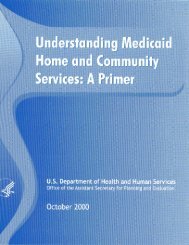Involving the Faith Community in Teen Pregnancy Prevention
Involving the Faith Community in Teen Pregnancy Prevention
Involving the Faith Community in Teen Pregnancy Prevention
You also want an ePaper? Increase the reach of your titles
YUMPU automatically turns print PDFs into web optimized ePapers that Google loves.
INVOLVING THE KEY PLAYERS38REMEMBER...At any <strong>in</strong>itial meet<strong>in</strong>gs, staffshould be prepared to cover thisground. Without a commonunderstand<strong>in</strong>g of <strong>the</strong> problem, littleenergy for a real partnershipwill develop.To help reduce teen pregnancy,faith communities do not have toimplement sexuality educationprograms or become familyplann<strong>in</strong>g cl<strong>in</strong>ics. In particular,<strong>the</strong>y do not have to change <strong>the</strong>irposition on <strong>the</strong> value of delay<strong>in</strong>gsex until marriage. This may be<strong>the</strong> most important idea of all.Much of what faith communitiesalready do is help<strong>in</strong>g to reduceteen pregnancy, and at no po<strong>in</strong>tshould it be suggested thatunless <strong>the</strong>y beg<strong>in</strong> provid<strong>in</strong>g sexeducation or related services,<strong>the</strong>y are not help<strong>in</strong>g to solve <strong>the</strong>problem. It may be that a particularfaith community will wantto support contraceptive cl<strong>in</strong>icsor sexuality education, but manywill not, and it is vitally importantthat whatever <strong>the</strong>ir takeon sex education, <strong>the</strong>y stillbe among a program’s friendsand colleagues.Research <strong>in</strong>creas<strong>in</strong>gly suggeststhat broad youth developmentprograms—some of <strong>the</strong> best ofwhich are offered through faithcommunities—can make signiicantdents <strong>in</strong> teen pregnancy.<strong>Faith</strong> communities are alreadymak<strong>in</strong>g an enormous contributionthrough <strong>the</strong>ir work withyouth generally, <strong>the</strong>ir supportof families and marriage, <strong>the</strong>irefforts to improve parent-childcommunication, <strong>the</strong>ir childcare services and after-schoolprograms, <strong>the</strong>ir sport and recreationalactivities, and <strong>the</strong>irdirect engagement with valuesand moral choices. Make itclear that regardless of whatspecific activities are undertaken,programs and faith communitiescan support each o<strong>the</strong>r aseach tries to reach <strong>the</strong> youngpeople with<strong>in</strong> <strong>the</strong>ir particularsphere of <strong>in</strong>fluence. The ma<strong>in</strong>message to faith groups is oneof support and respect.At some po<strong>in</strong>t, a program maywant to ask a community to dosometh<strong>in</strong>g more explicitly aimedat prevent<strong>in</strong>g teen pregnancy,but <strong>in</strong> mak<strong>in</strong>g such a pitch, it isessential for programs to honorwhat faith communities arealready do<strong>in</strong>g.One model for faith-based youthdevelopment is Unit<strong>in</strong>gCongregations for YouthDevelopment. This is a multiyearproject designed to equipfaith communities to streng<strong>the</strong>n<strong>the</strong> developmental foundationthat all children and youth needto grow up healthy. The projectoffers <strong>the</strong> opportunity for youthworkers to participate <strong>in</strong> <strong>in</strong>terfaithnetworks. They receive
















